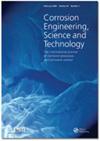制冷剂吸收剂组合对吸收式制冷系统结构材料铜耐腐蚀性能的影响
IF 1.5
4区 材料科学
Q4 MATERIALS SCIENCE, MULTIDISCIPLINARY
Corrosion Engineering, Science and Technology
Pub Date : 2023-09-28
DOI:10.1080/1478422x.2023.2261782
引用次数: 0
摘要
摘要本文研究了吸附式制冷系统(ARS)中溴化锂(LiBr)、硝酸锂(LiNO3)和氯化钙(CaCl2)等制冷剂-吸附剂组合存在时铜的耐腐蚀性能。采用开路电位、电化学阻抗谱、电化学噪声分析和动电位极化曲线等电化学技术,研究了测试溶液组合对结构材料铜在ARS中的腐蚀速率的影响。OCP分析表明,Ecorr随温度和测试溶液的变化而变化。同时,当铜在80℃的LiBr/H2O + CaCl2中浸泡时,腐蚀电流密度(Icorr)较低(0.003 mA/cm2)。此外,从EIS估计的Rp显示在80°C时增加。铜表面浸在LiBr/H2O和LiBr + CaCl2中的显微照片观察到裂纹和凹坑。而且,当腐蚀产物层被去除时,表面的非均匀性更少。关键词:腐蚀吸附制冷系统(ARS)含铜化合物混合物披露声明作者未报告潜在利益冲突。数据可得性声明支持本研究结果的数据可根据通讯作者的合理要求提供。本文章由计算机程序翻译,如有差异,请以英文原文为准。
Effect of refrigerant absorbent combinations in the corrosion resistance of copper as structural material in absorption refrigeration systems (ARS)
ABSTRACTThe present research was focused on analyzing the corrosion resistance of copper in the presence of refrigerant-absorbent combinations such as lithium bromide (LiBr), lithium nitrate (LiNO3) and calcium chloride (CaCl2), used in Adsorption Refrigeration Systems (ARS). Electrochemical techniques such as open circuit potential, electrochemical impedance spectroscopy, electrochemical noise analyses and potentiodynamic polarisation curves were applied to study the test solution combination effect on the corrosion rate of copper as a structural material in ARS. OCP analyses reveal that the Ecorr shifted based on the temperature and test solution. Meanwhile, when the copper was immersed in LiBr/H2O + CaCl2 at 80°C, the corrosion current density (Icorr) was lower (0.003 mA/cm2). Also, The Rp estimated from EIS shows an increase at 80°C. Micrographs of the copper surface immersed in LiBr/H2O and LiBr + CaCl2 observed cracks and pits. But also, when the corrosion product layer was removed, a less heterogeneous surface was revealed.KEYWORDS: Corrosionadsorption refrigeration systems (ARS)copperabsorbent compounds mixture Disclosure statementNo potential conflict of interest was reported by the author(s).Data availability statementThe data supporting this study’s findings are available from the corresponding author upon reasonable request.
求助全文
通过发布文献求助,成功后即可免费获取论文全文。
去求助
来源期刊

Corrosion Engineering, Science and Technology
工程技术-材料科学:综合
CiteScore
3.20
自引率
5.60%
发文量
58
审稿时长
3.4 months
期刊介绍:
Corrosion Engineering, Science and Technology provides broad international coverage of research and practice in corrosion processes and corrosion control. Peer-reviewed contributions address all aspects of corrosion engineering and corrosion science; there is strong emphasis on effective design and materials selection to combat corrosion and the journal carries failure case studies to further knowledge in these areas.
 求助内容:
求助内容: 应助结果提醒方式:
应助结果提醒方式:


